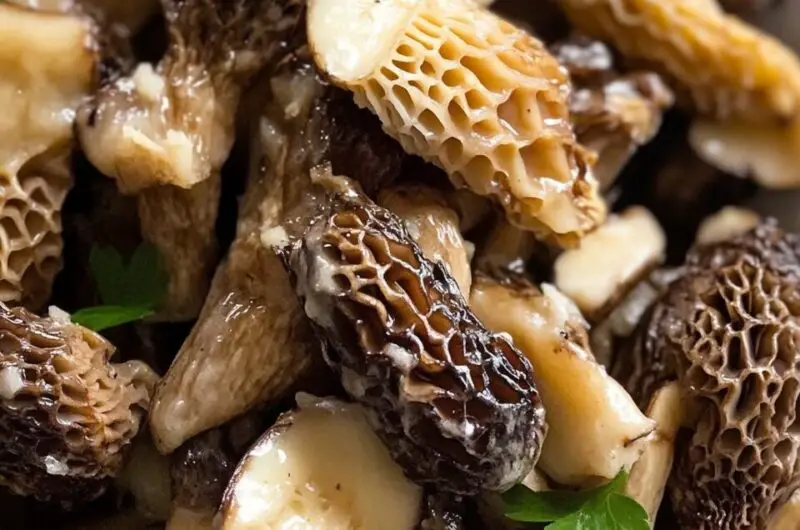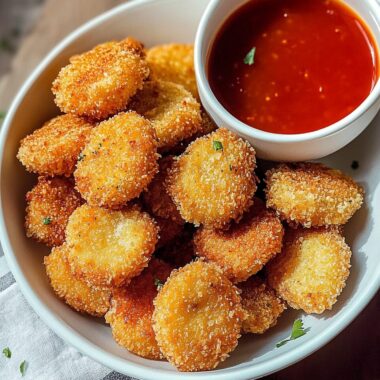The wild morel mushroom is one of spring’s most cherished foraged ingredients, and this simple sautéed dish highlights its earthy richness. When paired with the bold aroma of garlic and the silkiness of melted butter, morels transform into a culinary treasure that’s as rustic as it is elegant. Whether you just returned from a fruitful foraging trip or scored fresh morels at a local market, this recipe brings out the mushroom’s nutty, meaty essence without overcomplicating it. Serve it as a side dish, a toast topper, or even folded into creamy pasta for an unforgettable spring treat.
Full Recipe:
Ingredients:
-
1 pound fresh morel mushrooms
-
1/4 cup unsalted butter
-
2 tablespoons olive oil
-
3 cloves garlic, minced
-
Salt to taste
-
Freshly ground black pepper to taste
-
Optional: fresh parsley, chopped (for garnish)
Directions:
-
Clean the morel mushrooms thoroughly. Slice them in half lengthwise to ensure there are no insects or dirt inside.
-
In a large skillet over medium heat, melt the butter with the olive oil.
-
Add the garlic and sauté for 1–2 minutes until fragrant, being careful not to burn it.
-
Add the morel mushrooms to the skillet and cook for about 5–7 minutes, stirring occasionally, until they are golden brown and tender.
-
Season with salt and freshly ground black pepper to taste.
-
Remove from heat, sprinkle with fresh parsley, and serve warm as a side dish or over toast.
Prep Time: 10 minutes | Cooking Time: 10 minutes | Total Time: 20 minutes
Kcal: 220 kcal | Servings: 4 servings
Discovering the Delicacy of Morel Mushrooms
Morel mushrooms, also known as Morchella, are among the most coveted wild edibles in the culinary world. Their earthy, nutty flavor and meaty texture have made them a gourmet staple, particularly in springtime dishes. Unlike typical supermarket mushrooms, morels are foraged rather than cultivated, contributing to both their rarity and high value.
For those who have never tasted them, morel mushrooms offer a rich, umami-packed experience that pairs beautifully with simple ingredients making butter and garlic the perfect complements. The recipe for Sautéed Morel Mushrooms with Butter and Garlic is a timeless celebration of seasonal eating, foraged food, and rustic simplicity.
Why Morel Mushrooms Are So Special
What sets morels apart from other mushrooms is not just their honeycomb-like appearance, but also their short harvesting window and the fact that they grow wild. Found in forests, under trees, or in recently burned areas, morels have long captured the attention of mushroom hunters and foodies alike.
The flavor is deeply savory, with nutty and earthy undertones that intensify when cooked. Their texture holds up well in hot pans, making them ideal for sautéing, roasting, or even stuffing. Unlike other mushrooms that can become rubbery or slimy, morels maintain a firm bite and absorb flavor like a sponge.
Moreover, morels are considered a seasonal delicacy in North America and Europe. Their exclusivity only fuels the desire of chefs and home cooks who look forward to preparing them in early to mid-spring.
Foraging for Morels: A Springtime Tradition
Foraging for morel mushrooms has become a springtime ritual for many families and outdoor enthusiasts, especially in states like Michigan, Wisconsin, and Oregon. Hikes through wooded areas in search of the elusive fungi can be both meditative and thrilling, as morels blend seamlessly into the forest floor.
When foraging, it’s essential to know how to identify true morels and differentiate them from false morels, which can be toxic. True morels are hollow inside from the cap to the stem, whereas false morels are not. Always use reputable guides or forage with an experienced mushroom hunter when starting out.
Once harvested, morels should be cleaned gently but thoroughly. They are hollow and can harbor dirt or tiny insects, so slicing them lengthwise and soaking them briefly in salted water is a common practice.
Butter and Garlic: The Perfect Flavor Companions
When it comes to cooking morels, less is more. These mushrooms don’t need elaborate sauces or overpowering spices. The Sautéed Morel Mushrooms with Butter and Garlic recipe captures the spirit of letting the main ingredient shine.
Butter adds a creamy, indulgent richness that enhances the morels’ natural umami flavors, while garlic introduces a sharp aromatic note that adds depth without masking the mushrooms’ character. This classic combination allows the integrity of the morel to remain front and center, and the end result is a dish that’s elegant yet incredibly simple.
Adding a touch of olive oil helps raise the smoke point of the butter, preventing it from burning while giving the dish a well-rounded finish. A sprinkle of fresh parsley at the end lends a pop of color and herbal brightness.
Serving Ideas and Pairings
Sautéed morels are incredibly versatile and can be served in a number of ways. Here are a few pairing and presentation suggestions to inspire your culinary creativity:
-
On Toast: A rustic sourdough or country loaf makes the perfect canvas. Toasted, lightly buttered bread topped with warm morels is a luxurious breakfast or brunch option.
-
With Pasta: Toss the mushrooms with fresh pasta, a splash of cream or stock, and a handful of Parmesan for a simple yet restaurant-worthy meal.
-
With Steak or Grilled Meats: The umami-packed mushrooms make an ideal side for grilled steak, pork chops, or roasted chicken.
-
As a Topping for Risotto or Polenta: Their earthy flavors meld beautifully with creamy dishes, elevating a simple base into something extraordinary.
-
As a Side Dish: A bowl of these buttery mushrooms can stand alone as a gourmet side dish, especially when served alongside roasted vegetables or grains.
Nutritional and Culinary Benefits
Morels are not only delicious, but they also offer a number of nutritional benefits. They’re high in antioxidants, rich in Vitamin D, and contain significant amounts of iron, copper, and manganese. Because they are foraged from the wild, they are typically free of pesticides and chemicals, making them an appealing option for health-conscious eaters.
Culinarily, they absorb surrounding flavors with ease and caramelize beautifully in high heat, giving them an edge over more common mushrooms like white button or cremini. Their unique shape also provides excellent texture in finished dishes.
Storing and Preserving Morels
Fresh morels are delicate and should ideally be cooked within a day or two of harvest or purchase. However, if you do have leftovers, store them in a paper bag in the refrigerator. Avoid plastic, as it traps moisture and can cause them to spoil quickly.
Morels can also be preserved by drying, which intensifies their flavor. Simply slice and dry them using a dehydrator or low oven heat, then store them in an airtight jar. Rehydrate with warm water or broth before use. Dried morels are fantastic for sauces, stews, and soups.
Advertisement
Cooking Tips for Success
To get the most out of your Sautéed Morel Mushrooms with Butter and Garlic, keep these tips in mind:
-
Don’t Crowd the Pan: Overcrowding leads to steaming rather than sautéing. Cook in batches if necessary.
-
Medium Heat is Key: Butter burns easily, so maintain medium heat and add olive oil to stabilize it.
-
Avoid Overcooking: Morels should be browned but not shriveled or crispy. Aim for a tender yet meaty bite.
-
Garnish Last: Add herbs like parsley at the end to retain freshness and color.
-
Clean Thoroughly: Even store-bought morels can harbor grit. Slice and rinse gently but thoroughly.
Conclusion:
There’s something magical about transforming a handful of wild morels into a luxurious side dish with just butter and garlic. Whether you’re a forager or a foodie, this simple yet sophisticated recipe offers a deeply satisfying way to celebrate the flavors of spring.
Sautéed morel mushrooms represent more than just a meal they’re a connection to the seasons, to the land, and to culinary tradition. With minimal ingredients and a bit of care, you can enjoy one of nature’s finest delicacies in the comfort of your own kitchen.








